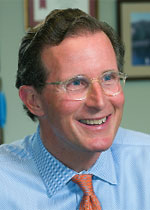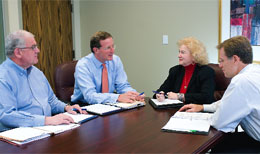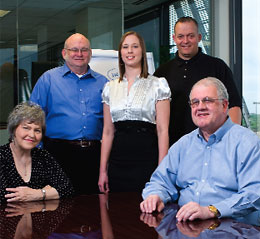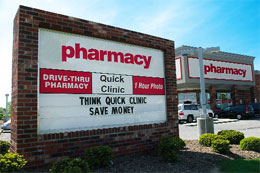|
Specialty superstore
U.S. Risk brings skill and savvy to challenging niche markets
By Elisabeth Boone, CPCU
When you walk through the doors of your local superstore, you’re always amazed at the variety and quantity of merchandise that’s strategically arrayed to capture your attention. From tulips to tires, from mowers to mattresses, from sweatshirts to shredders, it’s all there, stacked from floor to ceiling and priced to sell.
Although insurance policies aren’t the stuff of dazzling displays, it’s nonetheless possible for retail agents and brokers to shop in wholesale “superstores” for a wide variety of specialty coverages that meet their clients’ needs. Prominent among such facilities is U.S. Risk Insurance Group, Inc., a multifaceted organization with wholesale brokerage, underwriting, program management, risk management, and claims management units. Through its 12 domestic and international subsidiaries and affiliates, U.S. Risk offers a wide range of products and services, and it truly embodies the concept of a “specialty superstore.”
Unlike a conventional superstore, where you’re pretty much on your own when it comes to locating and loading up the items you seek, Dallas-based U.S. Risk is staffed with seasoned professionals who can find what a retail agent needs and tailor a custom package to meet a client’s specifications.
Art Seifert is president and chief underwriting officer of U.S. Risk Underwriters, Inc., one of the group’s principal units and the fifth largest specialty wholesaler in the country. He is also the founder of Lighthouse Underwriters, LLC, a specialty program company that he established in 1994 and sold to U.S. Risk in 2006. With a career that spans three decades on the retail and wholesale sides of the business, Seifert brings to his position both depth and breadth of experience from the front lines.
Well-stocked “shelves”
The amply stocked “shelves” of U.S. Risk Insurance Group are clear proof that the company truly is a “specialty superstore.” Within the group’s 12 operating units, Seifert says, “We provide four different services that generate revenue: wholesale brokerage and single-placement business; program and specialty underwriting; risk management, and claims management.”
He explains that wholesale and single-placement business is “traditional wholesale plus some MGA contracts we have with carriers like Markel and Scottsdale, where we place one-off individual accounts into an underwriting model for them based on their manual. In essence, this is non-program underwriting.” This business is conducted by U.S. Risk Brokers, a wholesale excess-surplus brokerage that offers all forms of property, casualty, automobile, umbrella, professional liability, and risk management products and services on behalf of more than 100 carriers nationwide.
Divisions of U.S. Risk Brokers specialize in arranging coverage for health care liability, professional liability, product liability, liquor liability, contractors, habitational, oil and gas, aviation, and financial services. NCG Professional Risks Ltd., a subsidiary based in London, is a Lloyd’s broker that specializes in professional indemnity, directors and officers liability, employment practices liability, U.S. professional lines, personal accident, bloodstock, international property and liability, U.S. property and catastrophe, marine, energy, and reinsurance.
Programs and specialty underwriting are the domain of U.S. Risk Underwriters, which is the unit Seifert manages. This MGA and underwriting manager represents 20 domestic carriers as well as several Lloyd’s syndicates. Lighthouse Underwriters, the firm Seifert founded, is a national program manager that designs products for specific industry groups and distributes them through retail independent agents and brokers.
Another profit center is risk management; services are provided by OmniSure Consulting Group, which offers consultation and support in all aspects of long term care, allied and miscellaneous health care, and restaurant risk management. “OmniSure is a classic risk management company,” Seifert says. “They will do site inspections; but with the softening of the market and carriers looking to reduce costs, OmniSure is moving more toward a content-rich online platform to deliver risk management services.”
On the claims side, “Our business is comprised of two entities: NovaPro Risk Solutions and Professional Claims Managers,” Seifert says. “NovaPro handles primarily workers comp and GL for large entities like the city of Chicago, and PCM works on professional liability claims and lawsuits for insurers, reinsurers, Lloyd’s of London, self-insured pools, public entities, and corporations with large self-insured retentions.”
Art and science
As the professionals who design specialty insurance programs will attest, the endeavor requires a thoughtful blend of art and science. Under the leadership of Art Seifert, U.S. Risk Underwriters creates programs that address the unique exposures of a wide range of niche markets. Seifert points with pride to four programs his company recently launched or enhanced, and in each case explains why the company decided to enter that market and how the program’s features meet the needs of its target classes.
Medical tourism. Relentless increases in the costs of health care in the United States, coupled with issues of availability and accessibility, are driving a trend toward seeking medical treatment overseas. Known as medical tourism, this growing trend creates a host of exposures for both the entities that arrange medical tours and the patients who travel to foreign countries for treatment. This, Seifert comments, is just the kind of challenge U.S. Risk Underwriters relishes.
“When I had Lighthouse, my primary objective was to monitor markets and see where the insurance industry had an opportunity to create a new product or improve an existing product,” Seifert explains. “I continue to do that at U.S. Risk Underwriters. I had been following medical tourism for a couple of years, and when I realized that it was becoming a significant phenomenon, we decided to develop a product. I talked with the president of the Medical Tourism Association and did other research to answer the question: ‘What kind of insurance product will help this industry grow?’”
Clearly, medical tourism’s popularity is surging because it offers uninsured or underinsured Americans the opportunity to receive needed treatment at a fraction of the cost they would pay in the United States. As Seifert realized, however, there’s more to the equation than saving money.
“If I go over to India to have my hip shaved, for instance, it might cost me, with air travel and hotel, $8,000 to $10,000 versus $45,000 to $60,000 in the States,” Seifert says. “That’s a significant savings—but if I come back to the States and I develop a medical complication, I could end up spending well more than the amount I would have spent if I’d had the original procedure done here. I thought that if we could design a product that would cover the cost of medical complications that are generated by work performed overseas, we could help the medical tourism industry grow,” he asserts.
In response, U.S. Risk Underwriters created MedTour, a combination travel insurance and medical complications policy with coverage for accidental death and disability, emergency evacuation and repatriation, trip cancellation and interruption, and other travel-related expenses.
“That was the first product we launched for this market, and it’s an admitted program with AIG,” Seifert says. “It’s purchased by medical tourism facilitators and offered to the customer as a value-added option, and it’s also appropriate for large employers that include medical tourism as part of their health plan. Additionally, it’s designed for health insurers themselves that are looking to adopt this model for their overall platform.”
Through the London nonadmitted market, U.S. Risk Underwriters offers MedTour Pro, which provides professional liability coverage on a claims-made basis for health care providers, medical tourism facilitators, and employers that offer medical tourism benefit options to their employees. “This coverage responds to claims that are not related to medical outcomes, like allegations that a trip wasn’t arranged properly or cost more than the participant expected,” Seifert explains.
The MedTour suite of products was launched in late 2008, and U.S. Risk Underwriters continues to introduce refinements to the products, Seifert says. “This is such a new industry, and it’s trying to find its bearings, but we’re very positive about it,” he points out. “We’ve been experimenting with viral marketing for this suite, and we’ve developed four podcasts for it. We’ve also been featured in a number of magazine articles (see “Medical Tourism on the Rise” in the August 2008 issue of Rough Notes), and I think we’re starting to gain traction.”
Quick clinics. Another trend that’s rapidly gaining traction in U.S. health care delivery is “quick clinics,” non-emergency medical treatment facilities that are located in retail pharmacy chain stores like Walgreen’s and CVS as well as big-box retailers such as Wal-Mart. Staffed by nurse practitioners rather than physicians, quick clinics are an appealing option for uninsured patients as well as for those with insurance who prefer not to wait hours in a crowded emergency room for treatment of non-life threatening conditions.
To address the exposures of quick clinics, U.S. Risk last year introduced Quick Clinic, a combined general liability and professional liability form with aggregate limits up to $10 million. Written in the London nonadmitted market, the product also provides coverage for sexual abuse, fire damage legal liability, automatic additional insured for host retailer, hired and non-owned autos, HIPAA, media defense, and property. A proprietary rating plan expedites cost estimation for adding multiple facilities.
“We saw that quick clinics were a new platform that would be the wave of the future for non-emergency, noninvasive medical services that people wanted to access quickly and conveniently,” Seifert explains. “Our objective was to develop a policy that was as comprehensive and price competitive as possible. Our product covers all the exposures mentioned above for an annual premium of $1,850.”
Like medical tourism, the concept of quick clinics is relatively new, Seifert points out. “Right now there are only about 50 companies in the country that manage these facilities, so our challenge is breaking into that relatively small group. We’re currently negotiating with one of the largest management firms, and I think that once we write this and additional accounts, it will be hard for anyone to take it away from us because our product is priced so competitively and is so comprehensive.”
Staffing industry. Another specialty product in the U.S. Risk portfolio targets the staffing industry. In addition to traditional temporary staffing firms, this category includes permanent placement firms (recruiters and headhunters), administrative service organizations, professional employer organization (PEO) firms in which the PEO is the employer of record, and contract professionals and teams.
Called StaffPak, the U.S. Risk policy covers property and liability exposures and is available nationwide except in Hawaii. StaffPak has been on the market since 1995, but in May 2009 an updated product was launched with a new A rated carrier, Seifert says.
“The key to the program has always been how we can offer the most comprehensive coverage to this group. When I first got involved in this class, only one market wrote coverage. If you were a temporary or permanent placement firm and you wanted general liability, professional liability, property, and fidelity, you had to fill out a separate application for each policy. I realized there was a better way, so I came up with the first package policy for the staffing industry, which prompted the other market to follow suit.”
The new version of StaffPak offers expanded and enhanced coverages that meet the needs of today’s staffing firms, Seifert says. “It covers general liability, employment practices liability, employee benefits liability, and professionals on an occurrence basis. We can offer it on either an admitted or nonadmitted basis, depending on what works best for the agent.
Entertainment industry. Technology has revolutionized the entertainment industry. In particular, audiovisual equipment has become smaller and smaller, which allows it to be used in a variety of locations outside the studio. Much of this high-value equipment, Seifert observes, is critical in generating income and can be difficult to replace quickly.
To address inadequacies in traditional approaches to insuring these exposures, U.S. Risk Underwriters offers Take 1, which is underwritten by an A rated carrier that has expertise in the entertainment industry. Target classes are audiovisual and multimedia production companies, audiovisual equipment dealers, equipment rental firms, and satellite uplink facilities.
The program includes a manuscript inland marine form that provides broad coverage for equipment. Also available is a package that covers production, negative film, videotape, faulty stock, and other exposures. General liability is written on an occurrence basis with limits to $1 million/$2 million; professional liability is available with limits to $2 million. Property is covered on an all-risk basis with replacement cost valuation. Also available are automobile, umbrella, and workers compensation coverages. Take 1 has been endorsed by the International Communications Industries Association since it was introduced in 1994.
Reaching out
When crafting policies for emerging industries with unfamiliar exposures, the first thing Art Seifert and his team do is to reach out to the experts in those industries to find out what they need. As those needs evolve and change, Seifert and his colleagues refine their products and sometimes relaunch them with new markets.
After all, that’s what it takes to succeed as a specialty superstore.
For more information:
U.S. Risk Underwriters, Inc.
Web site: www.usrisk.com/underwriting
|
|
| |
“My primary objective [is] to monitor markets and see where the insurance industry has an opportunity to create a new product or improve an existing product.”
 |
Art Seifert
President and
Chief Underwriting Officer
U.S. Risk Underwriters, Inc. |
|
| |
 |
| |
U.S. Risk program managers include (from left): Arthur J. McDevitt, CPCU, Vice President; Arthur B. Seifert, CPCU, CIC, RPLU, President; JoAnn Taylor, Executive Vice President; and Peter Stanislaw, CIC, CRM, RPLU, Vice President/StaffPak Program Director. |
| |
 |
| |
The Energy program team includes (seated) Carolyn Kennedy, Assistant Underwriter; Arthur McDevitt; (standing, from left) Cecil W. Rhodes, Vice President & Senior Underwriter; Larissa Yelverton, Underwriting Assistant; and John Looney, Underwriter. |
| |
 |
| |
The Professional Liability program team (from left): Danae Plotner, Assistant Underwriter; Kristina Dixon, CIC, Senior Underwriter; and Thomas J. Lane, Senior Underwriter. |
| |
 |
| |
| With Peter Stanislaw (front, center) is the StaffPak Program team (from left): Bobbie Watkins, Assistant Broker; Quinton Goss, Underwriter; Jeff Hicks, Senior Underwriter; and Alice Lacy, Underwriter. |
| |
 |
| |
With JoAnn Taylor is the Healthcare Program team (from left): Dee Ann Stockwell, Arrhonda Payne and Margo Walker. |
| |
 |
| |
To address the exposures of non-emergency medical treatment facilities located in retail pharmacy chain stores, U.S. Risk created the Quick Clinic form.
|
| |
 |
| |
From left, Morgan McMillan, Vice President of McGriff, Seibels & Williams of Texas and U.S. Risk’s JoAnn Taylor discuss coverage needs with John Falldine, Managing Director of Edgemere, a senior living facility. |
|